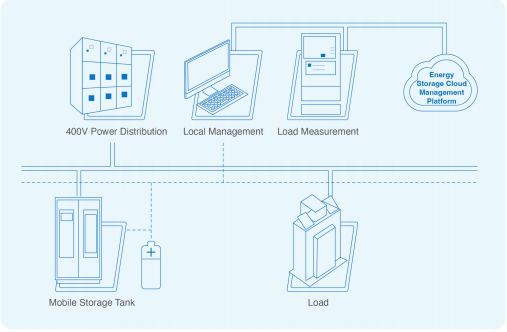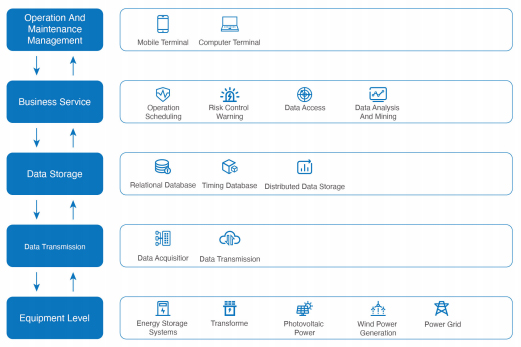
Aug . 17, 2025 00:40 Back to list
EMS for Advanced Energy Management & Storage
The Imperative of Modern Energy Management Systems
In an era defined by increasing energy demands, fluctuating costs, and a global pivot towards sustainability, the strategic optimization of energy consumption has become paramount for industries worldwide. This critical need underpins the rapid evolution and deployment of sophisticated Energy Management Systems (EMS). An Energy Management System (EMS) represents the central nervous system for any modern energy infrastructure, meticulously monitoring, controlling, and optimizing energy generation, distribution, and consumption across diverse applications. From large-scale industrial complexes and commercial buildings to burgeoning microgrids and advanced energy storage solutions, EMS solutions are instrumental in enhancing operational efficiency, reducing carbon footprints, and ensuring grid stability. The global market for energy management systems is projected to reach significant valuations, driven by stringent energy efficiency regulations, the proliferation of renewable energy sources, and the escalating demand for smart grid technologies. This growth underscores a transformative shift in how organizations perceive and manage their energy assets, moving beyond reactive measures to proactive, data-driven strategies for energy independence and resilience. For entities involved in energy storage and distribution, understanding the nuances of these systems is no longer optional but a strategic imperative to maintain competitiveness and lead in the evolving energy landscape. The integration of artificial intelligence and machine learning within these systems further amplifies their capabilities, enabling predictive analytics and autonomous optimization, a leap forward from traditional energy monitoring paradigms. This technological advancement positions ems at the forefront of the global energy transition, providing crucial tools for businesses to navigate the complexities of modern energy ecosystems and unlock unprecedented levels of efficiency and cost savings. This comprehensive approach ensures that every joule of energy is utilized efficiently, contributing to both economic prosperity and environmental stewardship, thereby creating a sustainable future for industries and communities alike.
Deep Dive into Energy Management System (EMS) Core Components and Manufacturing Excellence
An ems is not a monolithic entity but a sophisticated orchestration of interconnected hardware and software components designed to achieve optimal energy performance. At its core, an energy management system typically comprises several vital subsystems: the Battery Management System (BMS), the Power Conversion System (PCS), and the Supervisory Control and Data Acquisition (SCADA) system. The BMS is crucial for monitoring and controlling individual battery cells or modules, ensuring their safety, longevity, and optimal performance by managing parameters such as voltage, current, temperature, and state of charge (SoC) and state of health (SoH). The PCS acts as the bridge between the battery energy storage system and the grid or load, converting DC power from batteries to AC power for consumption or vice versa, facilitating precise power flow control, and enabling grid-tied or off-grid operations. The SCADA system provides the overarching intelligence, collecting real-time data from all connected devices and sensors, processing this information, and allowing operators to monitor, analyze, and control the entire energy infrastructure remotely. This integrated approach allows the ems to perform critical functions such as peak shaving, load shifting, demand response, renewable energy integration, and microgrid stabilization.
The manufacturing process for a high-quality ems involves rigorous stages to ensure reliability, durability, and precision. It begins with the careful selection of robust materials, often including high-grade steel for enclosures to ensure structural integrity and corrosion resistance, and advanced semiconductor materials for power electronics to guarantee efficiency and thermal management. Key manufacturing processes include precision CNC machining for component fabrication, ensuring exact tolerances for critical parts; advanced welding techniques for robust structural assembly; and automated assembly lines for consistent quality and throughput. For specialized components like power inductors or transformers, processes like winding and impregnation are meticulously controlled. Quality assurance is integrated at every stage, from raw material inspection to in-process checks and final product validation. Products adhere to stringent international testing standards such as ISO 9001 for quality management, ISO 14001 for environmental management, and ANSI/UL standards for electrical safety and performance, ensuring they meet the highest benchmarks for reliability and operational safety. A typical ems is engineered for an operational lifespan of 15-20 years, depending on environmental conditions and maintenance protocols, delivering long-term value. This meticulous manufacturing approach is vital, especially for products destined for demanding sectors such as petrochemical, metallurgy, water supply and drainage, and data centers, where system reliability and resilience are non-negotiable.

In these typical application scenarios, the advantages of a well-engineered ems are profound. In petrochemical facilities, the ems can optimize the power supply to critical processes, preventing costly downtime due to power fluctuations and ensuring energy-efficient operation of large motors and pumps, significantly reducing overall energy consumption and operational costs. For metallurgical plants, which are inherently energy-intensive, the system can manage peak loads, utilize off-peak energy storage, and integrate waste heat recovery systems, leading to substantial energy savings and enhanced production stability. In municipal water supply and drainage systems, the ems optimizes pump schedules based on demand and energy tariffs, ensures continuous operation during grid disturbances, and minimizes energy expenditure associated with water distribution and treatment, thereby lowering public utility costs and improving service reliability. Furthermore, the inherent corrosion resistance of selected materials and protective coatings ensures the longevity of ems components even in harsh industrial environments, offering a robust solution that delivers consistent performance and significant return on investment through reduced energy expenditure and improved operational resilience. The comprehensive design and stringent manufacturing processes ensure that these systems not only meet but exceed the demanding requirements of critical infrastructure, providing a reliable and sustainable energy backbone.
Technical Parameters and Performance Benchmarks of Advanced EMS Solutions
Understanding the technical specifications of an energy management system is crucial for effective deployment and integration into existing or new energy infrastructures. These parameters define the system's capabilities, performance, and suitability for various applications. High-performing ems solutions are characterized by robust communication protocols, precise control algorithms, and comprehensive data acquisition capabilities. For instance, a typical commercial ems deployed in conjunction with a battery energy storage system (BESS) might feature high sampling rates for real-time data, enabling swift responses to grid signals or internal load changes. Its communication interfaces often include Modbus TCP/IP, CAN bus, and proprietary protocols to ensure seamless integration with diverse energy assets, from solar inverters to industrial machinery. The processing power of the system's embedded controller dictates its ability to handle complex optimization algorithms, such as those for demand forecasting, peak shaving, and energy arbitrage.

Below is a generalized table illustrating typical technical parameters for a high-performance ems designed for industrial and commercial applications. These figures are illustrative and can vary based on specific system configurations and application demands, but they provide a benchmark for evaluating system capabilities. The operational environment, including temperature range and humidity, is also critical for ensuring long-term reliability, particularly in harsh industrial settings. Furthermore, advanced ems often incorporate cybersecurity features, such as encrypted communications and secure access controls, to protect against unauthorized access and cyber threats, a growing concern for critical energy infrastructure. The scalability of the system, allowing for future expansion and integration of additional energy assets, is another key consideration, ensuring the ems remains a viable solution as energy needs evolve. Performance metrics like reaction time to grid signals and prediction accuracy for energy demand are also paramount, directly impacting the system's effectiveness in achieving energy cost reductions and stability.
| Parameter | Description | Typical Value/Range |
|---|---|---|
| System Capacity Range | Scalability for different energy storage sizes. | 100 kW to 100 MW+ |
| Communication Protocols | Supported industry standards for data exchange. | Modbus TCP/IP, CAN, IEC 61850, DNP3 |
| Data Sampling Rate | Frequency of data collection from sensors. | 100 ms to 1 second |
| Control Latency | Time from command to execution. | Typically |
| Optimization Algorithms | Methods used for energy optimization. | AI/ML based, Linear Programming, Predictive Control |
| Operating Temperature Range | Environmental conditions for safe operation. | -20°C to +60°C |
| Cybersecurity Standards | Compliance with security protocols. | IEC 62443, NIST Framework |
| Reporting & Analytics | Features for data analysis and visualization. | Customizable dashboards, historical data, ROI analysis |
Choosing the Right Energy Storage Partner: Distinguishing Top Energy Storage Battery Companies and EMS Providers
The landscape of energy management and storage solutions is populated by numerous providers, making the selection of the right partner a critical strategic decision. When evaluating energy storage battery companies and ems solution providers, discerning clients prioritize several key differentiating factors beyond mere product specifications. Leading companies in this sector are distinguished by their comprehensive approach, encompassing not just hardware and software but also deep industry expertise, robust R&D capabilities, and an unwavering commitment to customer-centric solutions. These providers invest heavily in cutting-edge research to develop more efficient power conversion systems (PCS) and intelligent ems algorithms, often incorporating advanced AI and machine learning for predictive maintenance and optimized energy trading. Their product offerings are typically backed by extensive certifications from recognized bodies such as ISO, IEC, and local regulatory authorities, signifying adherence to the highest standards of quality, safety, and environmental responsibility.
Beyond technical prowess, the ability to offer highly customized solutions is a hallmark of superior providers. Each industrial or commercial client presents a unique energy profile and operational requirements, necessitating an energy management system that can be precisely tailored to integrate with existing infrastructure, accommodate specific load patterns, and achieve defined energy objectives. This includes flexible integration capabilities with various renewable energy sources (solar, wind), diverse battery chemistries (LiFePO4, NMC), and different grid connection points (behind-the-meter, front-of-the-meter). A strong provider will also demonstrate a proven track record through a portfolio of successful application cases across diverse industries, reflecting their practical experience and problem-solving capabilities. Their service model should extend beyond initial deployment, offering comprehensive after-sales support, including remote monitoring, proactive maintenance, and regular software updates to ensure the ems continues to perform optimally over its entire lifespan. This holistic view, from initial consultation and bespoke design to long-term operational support, truly sets apart industry leaders from conventional vendors, ensuring clients receive a future-proof investment that delivers sustained energy efficiency and resilience.

Real-World Impact: Application Cases and Enhanced Trustworthiness in EMS Deployment
The tangible benefits of an ems are best illustrated through real-world application cases that demonstrate significant energy savings, improved operational stability, and enhanced sustainability. Consider a large manufacturing plant facing high peak demand charges and frequent grid disturbances. By deploying an advanced energy management system integrated with a sizable battery energy storage system, the plant was able to precisely manage its energy consumption, shifting non-critical loads to off-peak hours and utilizing stored energy during peak periods. This strategy resulted in a 25% reduction in peak demand charges within the first year, alongside a 15% overall reduction in electricity costs. Furthermore, the ems provided seamless black start capabilities, ensuring uninterrupted production during unexpected grid outages, mitigating potential losses from downtime. This level of reliability and cost-effectiveness translates directly into a strong return on investment for the enterprise. Another compelling example is a data center grappling with rising energy costs and the need for continuous power supply. An ems enabled dynamic load balancing across multiple power sources, including grid power, on-site generators, and energy storage, prioritizing the most cost-effective and reliable option at any given moment. This led to a substantial decrease in grid dependency and a more stable power environment for sensitive IT equipment, while also demonstrating the facility’s commitment to energy efficiency.
Building trust with clients is paramount in the B2B energy sector. This is achieved not only through cutting-edge technology but also through transparent processes and robust support structures. Our commitment to client satisfaction is embedded in our service philosophy, starting with a clear delivery cycle for our ems solutions. Upon project finalization, typical delivery involves a phased approach: hardware shipment within 8-12 weeks, followed by software integration and commissioning within 4-6 weeks, depending on project complexity. This transparency ensures clients can plan their operations effectively. Furthermore, our products are backed by a comprehensive warranty, typically covering 5 years for major components and 10 years for software performance, providing peace of mind and demonstrating our confidence in product longevity. We also offer tiered customer support, ranging from 24/7 remote monitoring and troubleshooting to on-site technical assistance, ensuring that any operational issues are addressed swiftly and effectively. Our frequently asked questions (FAQ) module, accessible to all clients, provides instant answers to common queries regarding system operation, maintenance, and troubleshooting, empowering users with immediate information. This holistic approach to product quality, transparent processes, and unparalleled support reinforces our dedication to long-term partnerships and client success, making us a reliable choice for your energy management needs.
Frequently Asked Questions (FAQ) about Energy Management Systems
A: The Return on Investment (ROI) for an ems can vary significantly based on factors such as current energy costs, the scale of deployment, and specific optimization targets. However, many industrial and commercial clients report an ROI period ranging from 2 to 5 years, primarily driven by reduced energy bills from peak shaving, load shifting, and demand response programs, alongside improved operational efficiency and reduced downtime. Advanced energy management system installations, particularly those integrating renewable energy sources and intelligent analytics, often achieve faster ROIs due to greater efficiency gains and potential revenue streams from grid services.
A: A robust ems is designed for seamless integration with diverse existing energy infrastructure components, including legacy equipment. This is achieved through support for a wide array of industry-standard communication protocols (e.g., Modbus, DNP3, IEC 61850) and open APIs. Our engineers conduct a thorough site assessment to map existing systems (e.g., building management systems, SCADA, PLCs) and design a tailored integration plan, ensuring minimal disruption and maximum compatibility. This flexibility is crucial for industries where extensive retooling is impractical, allowing a phased upgrade path to a fully optimized energy management system without significant operational interruptions.
A: Our commitment extends far beyond the initial installation of your ems. We offer comprehensive post-deployment support packages that typically include 24/7 remote monitoring and diagnostics, proactive system maintenance, regular software updates for new features and security enhancements, and access to our dedicated technical support team. Training programs are also provided to ensure your operational staff are fully proficient in utilizing the energy management system’s capabilities. This continuous support ensures your system operates at peak performance, adapts to evolving energy needs, and remains secure against emerging threats, maximizing its long-term value and operational benefits.
References
- International Energy Agency (IEA). "Energy Efficiency 2023."
- U.S. Department of Energy. "Grid Modernization Initiative Strategic Plan."
- IEEE Transactions on Smart Grid. "Impact of Energy Management Systems on Industrial Energy Consumption."
- Journal of Energy Storage. "Advanced Battery Management Systems for Grid-Scale Applications."
This is the last article
-
EMS for Advanced Energy Management & Storage
NewsAug.17,2025
-
Boost Efficiency with Smart EMS Energy Management Systems
NewsAug.16,2025
-
Energy Management System (EMS): Optimize & Save Energy Costs
NewsAug.15,2025
-
Intelligent Energy Management: Save & Control Your Power
NewsAug.14,2025
-
Optimize Energy with Advanced Management Systems
NewsAug.13,2025
-
Energy Management System: Optimize & Save | OEM EMS Solutions
NewsAug.12,2025


